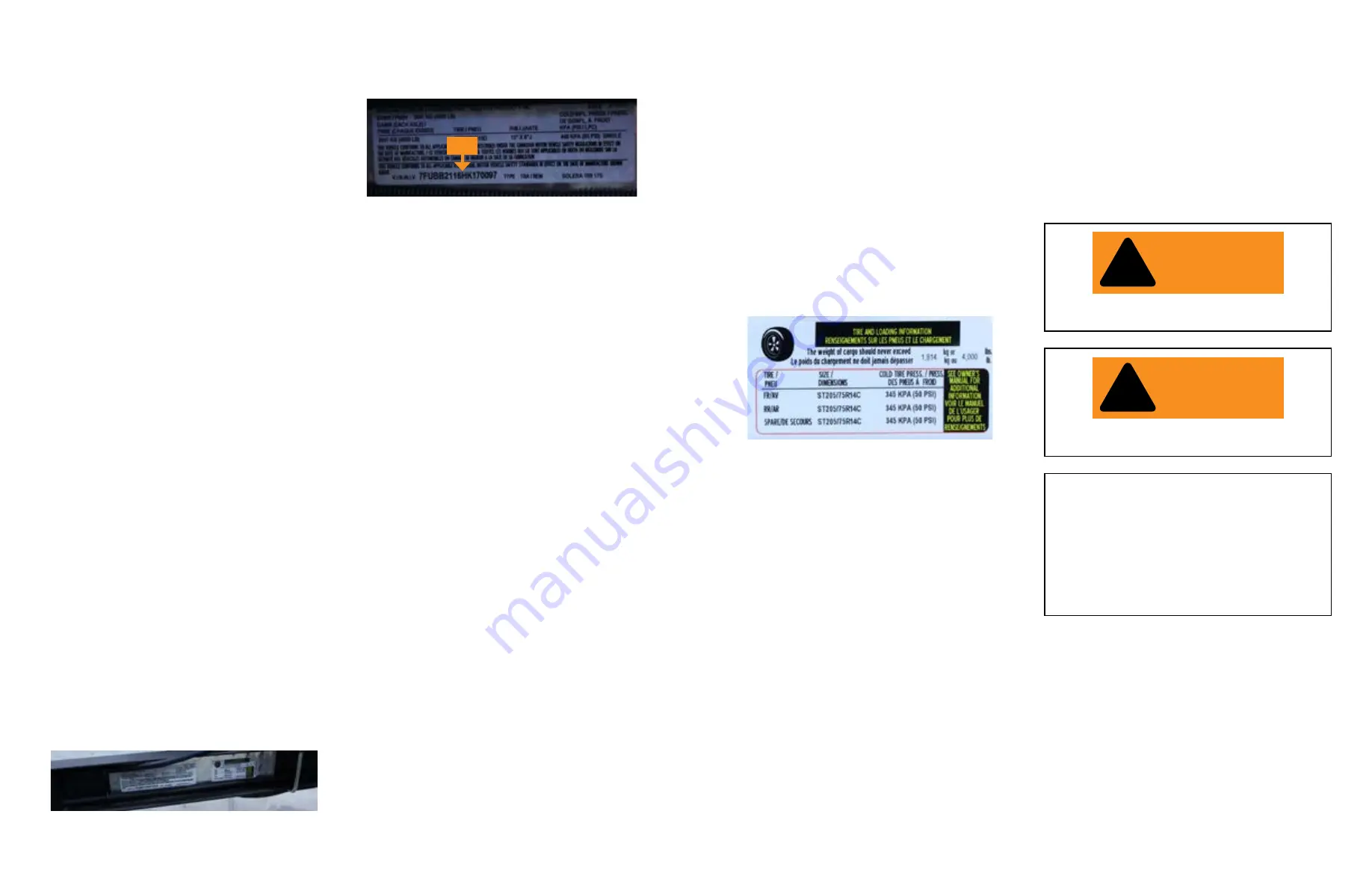
22
23
Tire, Care, Maintenance, and Safety
Practices
Before each trip, check each tire for:
Uneven wear Nails or other sharp objects.
Correct tire air pressure.
Tread separation.
Tread depth.
Proper tightening (torque) on the lug bolts or lug
nuts
Tire checking
•Check Tire pressure regularly (at least
once a month), including spare.
•Inspect tires for uneven wear pattern on
the tread, cracks, foreign objects, or
other signs of wear or trauma.
•Remove bits of glass and foreign objects
wedged in the tread.
•Make sure your tire valves have valve
caps.
•Check tire pressure before going on a long
trip.
•Do not overload your vehicle. Check the
Tire Information and Loading Placard or
User’s Manual for the maximum
recommended load for the vehicle.
Bulges or other deformities of the
sidewall of the tire.
If bulges or other deformities exist, do not use
the trailer until the condition is corrected.
Preventing Tire Damage
•Slow down if you have to go over a
pothole or other object in the road.
•Do not run over curbs or other foreign
objects in the roadway, and try not to strike
the curb when parking.
Vehicle Placard and Tire Inflation
Pressure Label Information and
Location
The Vehicle Placard and Tire Inflation
Label are affixed to the forward part of the trailer
near where the main frames meet the tongue.
VIN # & TIRE Inflation Pressure Label Information
Location SKEETER Custom Trailer’s VIN number
begins with 7FUBB
.
Vehicle Placard (Example)
Determining load limits
The load limit on a boat trailer is referred
to as carrying capacity. The carrying capacity of
your SKEETER trailer must be more than or equal
to the weight of the boat and everything in or on
the boat, including motor(s), fuel, water, personal
gear and other items you may have on board.
The final weight of all these items is call a “net
weight” and must not exceed the carrying capacity
of the trailer. The carrying capacity should not be
confused with the GVWR rating of the trailer. The
GVWR (Gross Vehicle Weight Rating) listed for the
trailer is the maximum allowable combined weight
of the trailer, boat, motor, fuel and gear. (See page
5, Choosing the Right Trailer.)
1. Locate the statement, “The weight of cargo
should never exceed XXX kg or XXX lbs.”, on
your vehicle’s placard.
2. Determine the empty weight of your trailer
by weighing the trailer using a public scale or
other means.
3. Locate the GVWR of the trailer on your trailer’s
VIN (Certification) label.
4. Subtract the empty weight of your trailer from
the GVWR stated n the VIN label. That weight
is the maximum available cargo capacity of the
trailer and may not be safely exceeded.
VIN
Do not Exceed Load Carrying
Capacity or GVWR
The weight capacity of your trailer is found using
the Gross Vehicle Weight Rating (GVWR) of
the trailer. The GVWR is printed on the Vehicle
Identification Number (VIN) decal at the right front
of the trailer (viewing trailer from the rear). This is
the MOST weight the fully loaded trailer can weigh.
When loading your cargo , be sure it is distributed
evenly to prevent overloading front to back and
side to side. Heavy items should be placed low and
as close to the axle positions as reasonable. Too
many items on one side may overload a tire. The
best way to know the actual weight of the vehicle
is to weigh it at a public scale.
Tire Information Pressure Label (Example)
Talk to your dealer to discuss the weighing
methods needed to capture the various weights
related to the trailer. This would include the weight
empty or unloaded, weights per axle, wheel, hitch
or king-pin and total weight. The trailer must not
be connected to the tow vehicle when you get the
total weight of the of the trailer. It is up to you to
make sure the weight of your boat, trailer, and boat
car go does not exceed the GVWR. Proper load
distribution on your trailer is also very important.
Tongue weight should be no less than 5% of
recommended of specific GVWR and not to exceed
the tongue weight capacity of the hitch. Five to
ten percent of your trailer’s Gross Vehicle Weight
should be supported by the hitch ball, with the
tongue level. This is called “tongue weight”. If you
are over or under the standard weight distribution,
try moving gear inside your boat first. If further
adjustment to the trailer is necessary, contact your
SKEETER Dealer.
Locating the Load Limit Information
The manufacturers VIN label has both the carrying
capacity and the GVWR (Gross Vehicle Weight
Rating) of your trailer. It also has tire size, cold
tire pressure, VIN number, date of manufacture
and other important information. The VIN label is
located on the trailer frame towards the front end
of the trailer rail.
Your trailer’s GVWR must not exceed the capacity
of your hitch.
Make sure the total weight of the trailer, boat, engine, fuel,
batteries, and gear does not exceed the trailer’s GVWR.
Check with your SKEETER Dealer or
automotive dealer to make sure you have the proper towing
vehicle for the load you will be pulling. Check your vehicle
manufacturer’s hitch weight recommendations as well.
Be sure you have the right size ball, shank and capacity to
match your trailer’s model and coupler size. The correct ball
size and capacity is marked on the coupler.
WARNING
!
WARNING
!
IMPORTANT




































